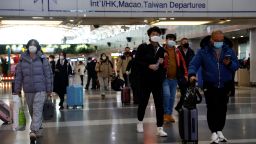As the world enters a new year, many public health and infectious disease experts predict that monitoring for new coronavirus variants will be an increasingly important part of Covid-19 mitigation efforts – and some are turning their attention to a surge in cases in China.
Subvariants of the Omicron coronavirus variant continue to circulate globally, and “we’re seeing Omicron do what viruses do, which is it picks up mutations along the way that helps it evade a little bit of immunity that’s induced by previous infection or vaccination,” said Andrew Pekosz, a microbiologist and immunologist at the Johns Hopkins Bloomberg School of Public Health in Baltimore.
“We haven’t seen any major jumps in terms of Omicron evolution in some time,” he said. But “it’s getting to that stage where it’s something that we have to continue to monitor.”
In the United States, the Omicron subvariants BQ.1.1, BQ.1, XBB, BA.5, BF.7 and BN.1 are causing almost all Covid-19 infections, according to data from the US Centers for Disease Control and Prevention.
Omicron’s offshoots appear to dominate globally as well, but as the coronavirus continues to spread – especially in China after Beijing’s rapid easing of restrictions – there is now concern about where Covid-19 trends could be heading in 2023 and the risk of new variants emerging.
“It is a worry,” said Dr. William Schaffner, a professor in the Division of Infectious Diseases at Vanderbilt University Medical Center in Nashville and medical director of the National Foundation for Infectious Diseases. “And that, of course, has led to the CDC’s very recent announcement that they are going to oblige people who come to this country from China to be tested and test negative before they can come into the country.”
US health officials announced Wednesday that, starting January 5, travelers from China will be required to show a negative Covid-19 test result before flying to the country. Passengers traveling to the US from China will need to get tested no more than two days before flying and present proof of the negative test to their airline before boarding.
Officials also announced that the CDC is expanding the traveler-based Genomic Surveillance Program to airports in Seattle and Los Angeles, bringing the total number of airports participating to seven with about 500 weekly flights from at least 30 countries covered, including about 290 weekly flights from China and surrounding areas.
The Chinese government has not been sharing a lot of information about the genetic composition of the viruses that it’s seeing there, Schaffner said.
“Because the Chinese government was not doing that, that was the main reason CDC put this new travel requirement in place. It’s certainly not to prevent simple transmission of Covid from China here. We’ve got plenty of Covid. That would be like telling people not to pour a bucket of water into a swimming pool,” he said. “This travel testing requirement is a way to buy us some time and help create somewhat of a buffer between ourselves and China, should a new variant suddenly appear in that country.”
He added that the US will need “as much time as possible” to update vaccines and antivirals to respond to a potential emerging variant of concern.
‘It really is a bit of a black hole’
The US testing requirements for travelers will “buy some time,” but they won’t prevent new Covid-19 cases from coming to the United States or new variants from emerging, said Dr. Carlos Del Rio, the executive associate dean for the Emory School of Medicine and Grady Health System in Atlanta.
“I don’t think we’re going to see much benefit, honestly,” he said of the travel requirements. “The most important thing we need right now is, we need the Chinese to have more transparency and tell us exactly what’s going on, and that is pretty much a diplomatic decision. This is about diplomacy.”
In terms of the genetic data on coronaviruses in China that is accessible to the public, “It really is a bit of a black hole,” Pekosz said. Almost 250 million people in China may have caught Covid-19 in the first 20 days of December, according to an internal estimate from the nation’s top health officials, Bloomberg News and the Financial Times reported last week.
“To me, what’s really a concern is the ongoing infections and whether they’re producing more variants in China that might be of particular concern for us, and testing people before they get on a plane won’t answer that question,” Pekosz said.
“What we really need is to do a much better job of sequencing the viruses from individuals who are traveling from China so that we can aid in terms of understanding what kinds of variants are circulating there,” he said, adding that throughout the pandemic, Chinese officials have not been very transparent about their data on variants.
More spread, more variants
Constant spread of a virus is what can lead to the emergence of variants. The more a virus spreads, the more it mutates.
“For a variant to emerge – and this is true not only for Covid, but for influenza and for a lot of other viruses – the most critical thing is, the more cases that you have, the more likely that the virus will start to accumulate mutations that might have the ability to evade immunity more effectively or to transmit more effectively,” Pekosz said.
“So when you have a situation like what’s starting to turn out in China, where you’re going to have millions upon millions of infections, every one of those infections is just one additional opportunity for the virus to pick up a random mutation that might make it better at infecting people,” he said. “Combine that with the fact that the Chinese population has been using less-than-optimal vaccines and has apparently not been as good about putting boosters into their population as other countries have, that means that there’s probably a lower amount of immunity in the population.”
Health authorities in China have “noticeably increased” the number of coronavirus genome sequences and other related data they are submitting to the global database GISAID, an initiative that maintains databases for scientists around the world to share data on flu viruses and coronaviruses.
But many experts argue that it’s not enough.
GISAID said in an email to CNN on Wednesday that China’s Center for Disease Control and Prevention, and several regional centers in the country, “have noticeably increased the number of submissions of genome sequence and associated metadata from samples taken in recent days.”
The GISAID Data Science Initiative announced that it has released genome sequence data from 167 SARS-CoV-2 samples collected during the current outbreak in China. SARS-CoV-2 is the name of the virus that causes Covid-19. GISAID also confirmed that the sequences from China “all closely resemble known globally circulating variants seen in different parts of the world between July and December 2022,” compared with the 14.4 million genomes in GISAID’s database.
“These latest data provide a snapshot of the evolution of the Omicron variants and shows that these most recently shared sequences from China are closely related to variants that have been circulating for some time,” according to the GISAID Data Science Initiative.
What the future may hold
Covid-19 is in a relatively “stable” state right now in the United States, but the nation still sees about 350 deaths related to the disease each day, said Dr. Jessica Justman, an associate professor of medicine in epidemiology at Columbia University Mailman School of Public Health and senior technical director of the global health program ICAP.
While Covid-19 levels remain far below those of prior surges, trends are on the rise in parts of the US, new hospital admissions have jumped nearly 50% over the past month, and there is growing concern that case numbers could soar after the winter holidays.
To reduce the risk of increased Covid-19 spread, Justman said, it will be important for people in the new year to continue to stay up-to-date with their Covid-19 vaccinations.
Only 14.6% of the US population ages 5 and older has gotten their updated booster shot, according to CDC data.
“So where are we going? That does take me to China,” Justman said.
Get CNN Health's weekly newsletter
Sign up here to get The Results Are In with Dr. Sanjay Gupta every Tuesday from the CNN Health team.
“I’m concerned that China right now is one giant incubator of SARS-CoV-2. There is the potential to have so many infections and with that, new variants,” she said.
“I think we’re going to be looking at new variants of concern” in 2023, Justman said. “The question is: Will we go back to a point where we have a variant of concern that causes such severe illness that we don’t get the benefit of our protection from prior infections and from prior vaccinations? … I’m going to be optimistic and say I don’t think we’re going to go back to that point.”
CNN’s Arlette Saenz and Nikki Carvajal contributed to this report.
COVID-19 - Latest - Google News
December 30, 2022 at 06:35PM
https://ift.tt/jxrsLuM
2022 ends with looming risk of a new coronavirus variant, health experts warn - CNN
COVID-19 - Latest - Google News
https://ift.tt/SEbN0dJ
Bagikan Berita Ini



















0 Response to "2022 ends with looming risk of a new coronavirus variant, health experts warn - CNN"
Post a Comment